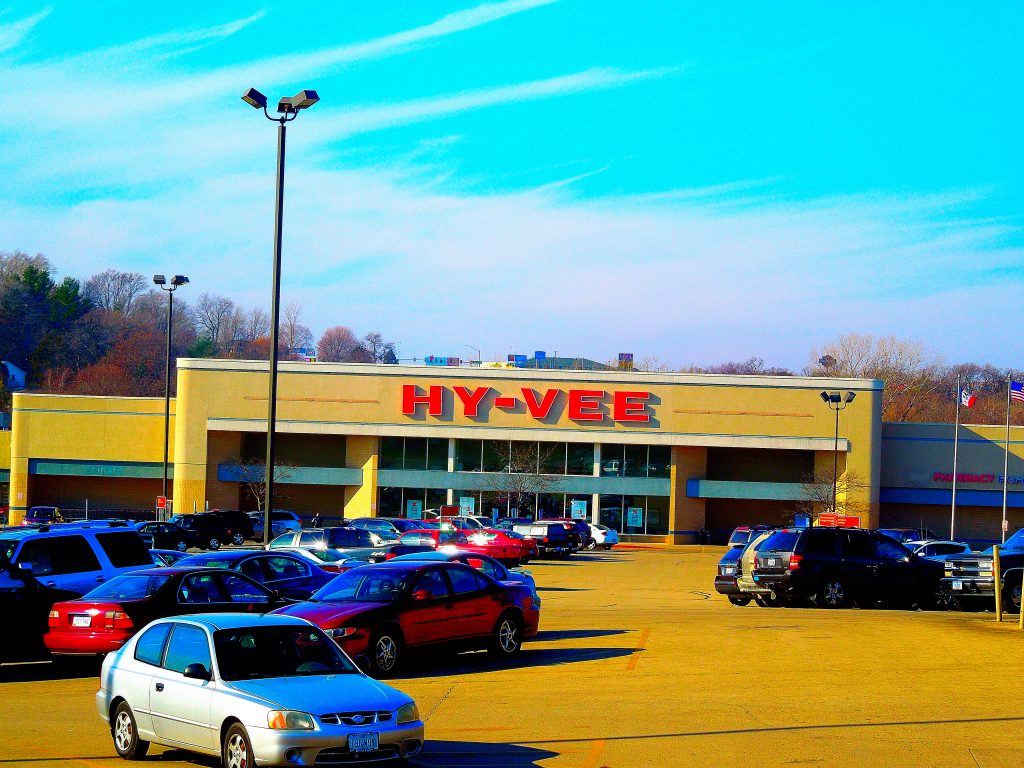
Grocery stores across the United States have made drastic changes to address customer and personnel safety during the COVID-19 pandemic. Many stores, like Walmart and Costco, have limited the number of customers allowed in the store at a time. For the Midwest grocery chain Hy-Vee, it has been anything but business as usual.
Hy-Vee has implemented a number of precautions, including: frequent sanitization; hours shortened from 8 a.m. to 8 p.m. with an hour before opening for those in at risk groups; the elimination of reusable bags; one-way aisles; distancing stickers at check-out; one entrance and exit from the store; and, perhaps most notably, plexiglass barriers between workers and customers at check-out.
All of these measures have been taken to reduce the amount of contact those in the store make with each other. While the distancing stickers and one-way aisles have managed to reduce the amount of traffic and interaction between people in the store, they are hard to enforce as they tend to congest and alter the typical ease and flow of the store. Another attempt has been made to limit shoppers to one person per household and one cart per person. This is also difficult to enforce as there are some – such as single-parent households and those with special needs – who cannot enter the store alone.
Brendan Davison, senior political science and history major and Hy-Vee worker, spoke to the Monitor about the effectiveness of the regional chain’s efforts.
“To some extent, this [the one-way aisles and distancing stickers] are also hindered by the layout of the store. I personally have found it difficult to follow these guidelines, although I do my best. In terms of enforcement, it can also be difficult. More could be done to remind people, but we aren’t going to use coercive measures to strictly enforce these,” said Davison.
Additionally, Hy-Vee has increased its Aisles Online services to meet growing demand. The store has increased time slots for grocery pick-up and delivery and has even partnered with delivery services such as Doordash and Shipt to complete more deliveries. To better protect workers and customers, the store will no longer require a signature for Aisles Online services. Receipts will be left in the bag, and workers will leave groceries outside of the front door without making contact with the customer.
“Perhaps what’s most significant is the increase in Aisles Online, our personal shopping department, which has increased significantly from about 3% of Hy-Vee’s business to 10% as a result of the crisis,” Davison said. “We advise customers to remain in their vehicles and allow the workers to load the groceries in the vehicle.”
At first, Hy-Vee did not require its staff to wear masks in the store, instead relying on a strong recommendation that employees bring and wear their own masks. However, beginning the week of April 26, the grocery chain made wearing masks a requirement in order to follow the CDC recommendation and began providing masks for employees.
Davison described to the Monitor the difficulty, and gradual ease, with which masks were provided to workers.
“Gradually, more and more employees started wearing their own masks, but customers seemed to have taken the lead on that (I’ve even seen one customer wearing a full-on military-style gas mask). Some customers have even been very kind and brought in homemade masks for employees to wear. One kind customer brought a whole bag of masks to give the Aisles Online department,” Davison said. “In recent weeks the store has begun providing cloth masks to the employees, but in many ways distribution of these masks could be improved, as many were simply not aware that they were available.”
As a form of hazard pay for their essential workers, Hy-Vee is giving a “10% appreciation bonus” on all hours worked from March 16 to May 3. Although the store chain is giving a 10 percent bonus, it is not giving the traditional hazard pay of an overall increased payment. This matters especially for low-wage workers like those of Hy-Vee, who are earning anywhere between $8-$20 an hour.
Through all of these measures, there could still be more precautions taken. Hy-Vee has not listed a limit on their website of the amount of customers allowed in the store – like other grocery chains have – nor has it taken further actions to enforce the measures already taken. Although, as Davison states, further enforcement is highly difficult to enforce.
“I do feel the store could do more to protect both workers and customers, such as instituting restrictions on the number of people in the store at a given time, as many other stores have done, and potentially even having temperature checks for people before they enter the store,” said Davison. “However, these are all very difficult to implement as they require staffing and equipment, some of which is hard to obtain at the moment.”
